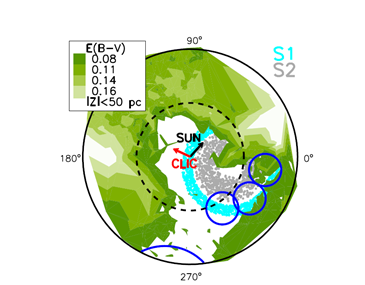Geomagnetic Record To Reveal Sun’s Route Through Galaxy
When galactic cosmic rays enter the atmosphere, they smash into nuclei forming various kinds of exotic by-products. Astrophysicists think that beryllium-10, chlorine-36 and carbon-14 in particular are formed in this way.

So it’s reasonable to think that that the abundance of these elements in the paleorecord should give some kind of indication of the flux of galactic cosmic rays at that time. But when geologists look, a puzzle emerges.
Here’s why. The Earth’s magnetic field acts like a shield to protect against this kind of bombardment. So in the first instance, the abundance of these exotic nuclei should follow the waxing and waning of this field.
The problem is that it doesn’t, at least not all of the time. “Several anomalies are found in these comparisons,” say Priscilla Frisch at the University of Chicago and Hans-Reinhard Mueller at Dartmouth College. And they think they know why.
Astronomers have known for some time that an increase solar activity can dramatically reduce the number of galactic cosmic rays reaching Earth because the solar wind and magnetic field deflect these particles away from us. But if solar variations can deflect these particles, Frisch and Mueller say it’s not unreasonable to think that other things can too.
It takes some 220 million years for the Sun to orbit the Milky Way. In that time it passes though numerous clouds of dust and gas of various densities and compositions. There’s no question that these must effect the amount of galactic cosmic rays coming our way, so shouldn’t this also show up in the paleorecord?
Frisch and Mueller say of course and go on to hypothesise that these effects can explain the anomalies that other scientists have found in these records.
One way to test this idea is to look for interstellar clouds the Sun has recently passed through and see whether any of the anomalies correlate with these anomalies. But there’s a problem here too. It’s difficult to work out the 3-dimensional structure of these clouds and this makes it difficult to know exactly when and if the Sun passed through them.
Frisch and Mueller conclude that changes in the galactic cosmic ray flux are certainly capable of explaining the anomalies in the data. But the result is by no means a slamdunk.
In addition to the uncertainties already mentioned, nobody is quite sure how galactic cosmic rays generate exotic nuclei or in what quantity. So a whole lot more work is need on the various processes involved.
That’s not to say the idea isn’t exciting. If the data can be accurately correlated with the Sun’s passage through clouds over the last 100,000 years or so, say, then it should be possible to use this logic in reverse. In other words, to take older paleorecords and use them to determine the structure of the clouds and dust through which the Sun has past, producing a 3D map of galactic dust clouds.
So the Earth itself is like a spaceprobe that has recorded its own journey as it swept through the galaxy on the coat tails of the Sun. All we have to do now is extract the data.
Ref: arxiv.org/abs/1010.4507: Time-variability in the Interstellar Boundary Conditions of the Heliosphere over the past 60,000 years: Impact of the Solar Journey on the Galactic Cosmic Ray Flux at Earth
Keep Reading
Most Popular
Large language models can do jaw-dropping things. But nobody knows exactly why.
And that's a problem. Figuring it out is one of the biggest scientific puzzles of our time and a crucial step towards controlling more powerful future models.
How scientists traced a mysterious covid case back to six toilets
When wastewater surveillance turns into a hunt for a single infected individual, the ethics get tricky.
The problem with plug-in hybrids? Their drivers.
Plug-in hybrids are often sold as a transition to EVs, but new data from Europe shows we’re still underestimating the emissions they produce.
Stay connected
Get the latest updates from
MIT Technology Review
Discover special offers, top stories, upcoming events, and more.